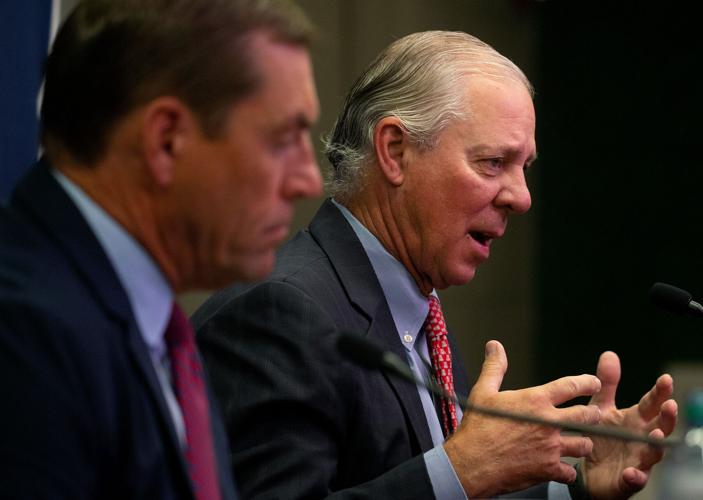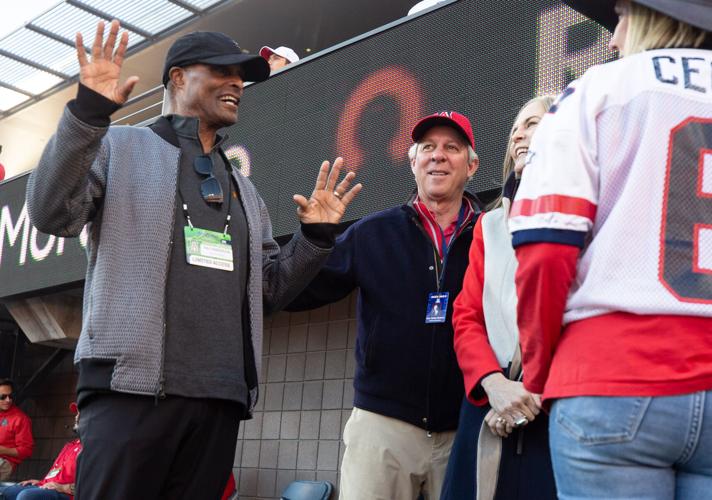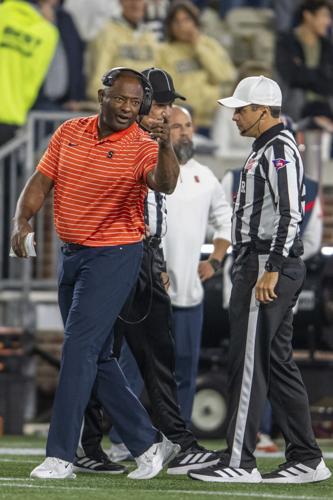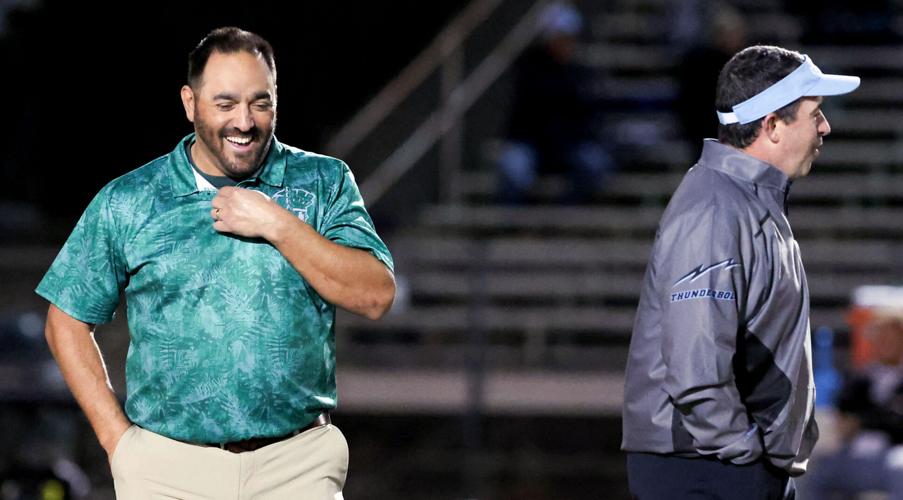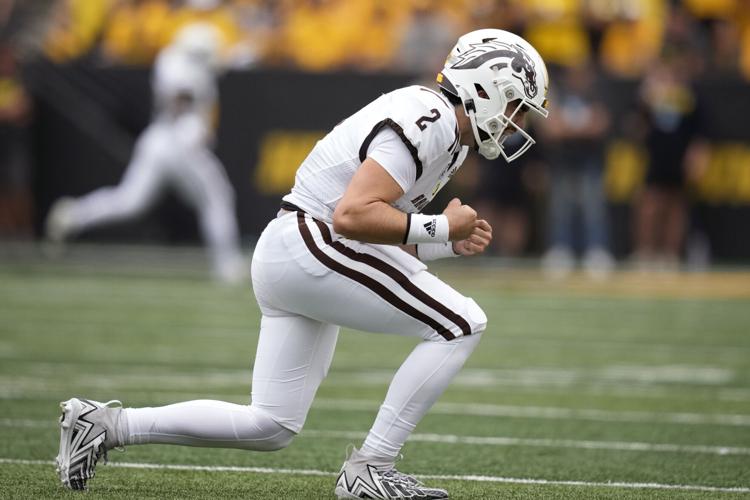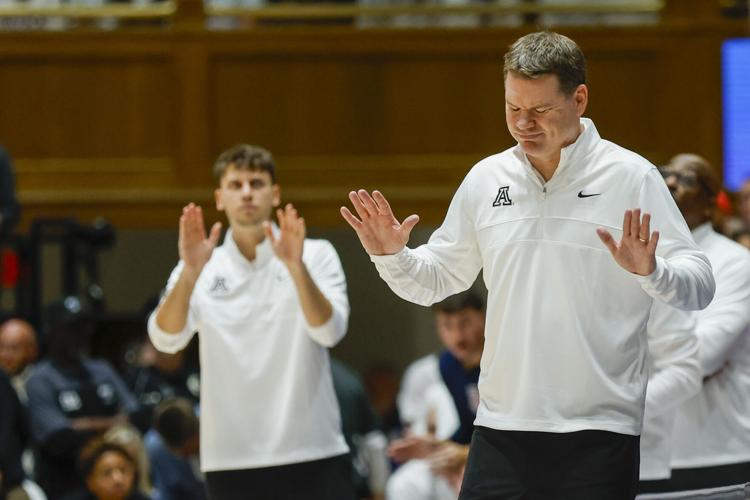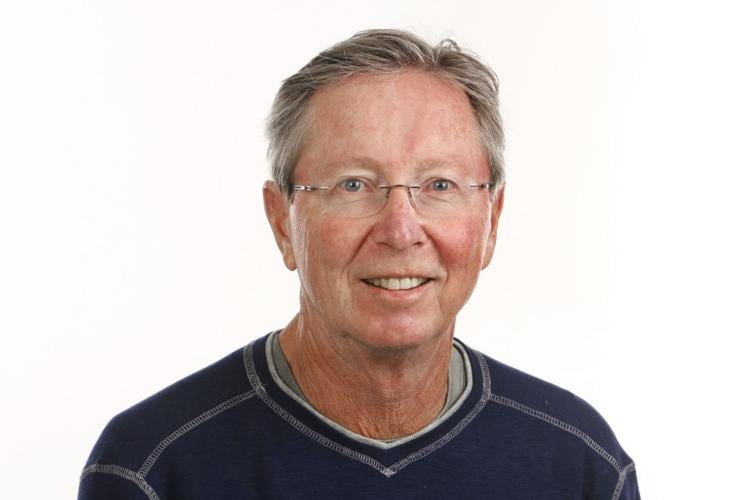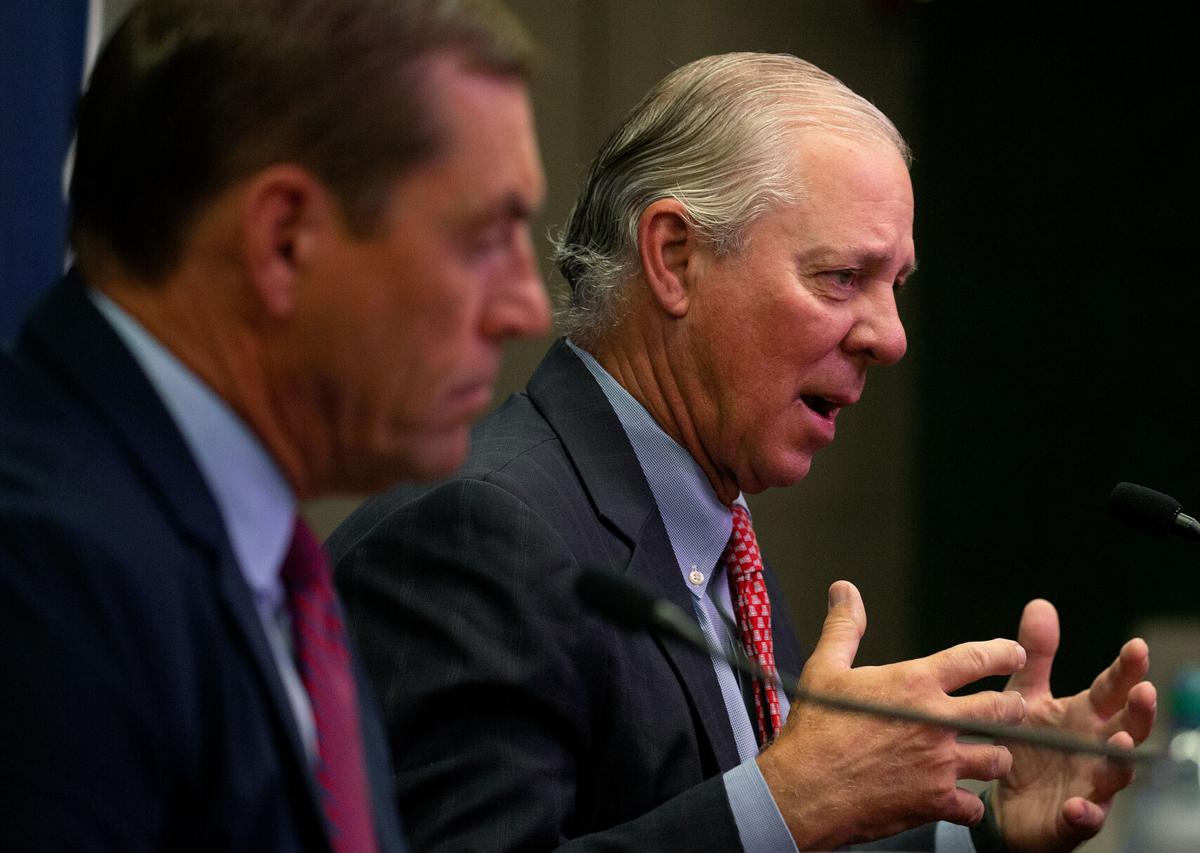The Star's longtime columnist also discusses the continuous ascension of Arizona basketball's Tommy Lloyd, Canyon del Oro High School football coach Dustin Peace's chance at championship history next week, what's facing ASU's next athletic director and more.
Hansen's Sunday Notebook is presented by Rite Way Heating, Cooling & Plumbing.
Sponsored: Have you spent money on your AC system? Rite Way will buy back your repairs up to $3,000. Break away from high electric bills and costly repairs! Plus Rite Way will give you the following on a new heating and air system: 0% financing up to 60 months; manufacturer rebates; 10-year parts and labor warranty; free estimates. Call or text (520) 201-8220 or visit RiteWayAC.com/Buyback.
Cutting lower-revenue UA sports won't move the financial needle enough

Greg Hansen is the longtime sports columnist for the Arizona Daily Star and Tucson.com.
In 1980, anticipating a budget deficit of $200,000, the University of Arizona last eliminated sports programs, cutting water polo, wrestling and men’s gymnastics. It hoped to save about $160,000 per year.
Part of its plan to become financially healthy was to raise football tickets from $10 to $11. (Yes, $1.) It also planned to reduce staff numbers in its equipment, training and sports information departments, cut back on recruiting trips and schedule fewer road games for non-revenue sports.
It's not 1980 anymore. Today, those figures and adjustments seem laughable.
I mean, the UA is in the process of building a $15 million golf facility at Tucson Country Club.
It pays its 10 assistant football coaches a collective $4.4 million. Its men’s and women’s basketball teams fly exclusively on private charter jets, which can exceed $20,000 for a one-game trip.
Since July, the Wildcats have added full-time assistant coaches in softball (Josh Bloomer), baseball (Toby DeMello), track (Dominic Johnson, Bob Myers and Egle Uljes), soccer (Sebastian Gardillo) and men’s tennis (Mateus Ceolin).
It has been keeping up with the Joneses.
Yet when it was recently revealed that the UA is facing a $240 million "miscalculation," school president Robert Robbins said, “the (financial) issue with athletics is serious. Athletics continues to be a vexing problem.’’ Robbins mentioned the possibility of eliminating sports for the first time in 43 years.
The two sports that seem most vulnerable are men’s track/cross country and men’s swimming. After all, they have the most athletes: 45 on the current track/cross country rosters and 34 on the men’s swimming/diving rosters.
But those numbers are misleading.
The NCAA allows only 9.9 scholarships for men’s swimming (to be spread over an entire roster) and 12.6 for track and field. Eliminating those sports would only save about $3.5 million per year, according to figures by the U,S. Department of Education, Equity in Athletics website.
Eliminating non-revenue sports doesn’t seem to be the answer. Men’s golf and men’s tennis only have 4.5 scholarships. Baseball is the largest financial loser among Arizona’s men’s sports, at roughly $2.5 million per year. But baseball at the UA is untouchable, the school’s most historically successful and traditional sport of the last 100 years.
Cutting baseball (or swimming or track) isn’t going to make a dent in Robbins’ $240 million campus-wide situation. What worked in the ’80s won’t work today.
In the 1980s, UA athletic director Cedric Dempsey began balancing the budget by implementing priority seating ticket prices at McKale Center and Arizona Stadium. For the first time, those in the prime seats began paying double (or more), a seat tax, for the privilege of sitting close to the action. The school had two full-time athletic department fund-raises. Now it has 16 in the fundraising department.
Today, the school compiles about $21 million per year in ticket sales with another $20 million in contributions from those ticket holders. Dempsey’s plan has skyrocketed. As it did, the more-more-more culture of college sports long ago got out of whack.
Now it seems like 1980 all over again.
The uncertain economic future of the University of Arizona has damaged the school’s brand and reputation. But eliminating sports isn’t going to fix the big financial issues. Not even close.

Then-ASU athletic director Ray Anderson and University of Arizona president Robert Robbins greet each other during the Arizona State at Arizona football at Arizona Stadium on Nov. 25, 2022.
ASU’s new athletic director inherits Anderson’s problems
When Arizona State athletic director Ray Anderson announced his resignation earlier this month, he defended his nine years as a Sun Devil by saying the athletic department is “in better shape than I found it.’’
Or maybe not.
Anderson said he was “frustrated that people didn’t appreciate’’ the success of ASU’s non-revenue sports and facility advancements. True, ASU built a grand golf facility worth almost $20 million, a hockey arena, worth close to $100 million, and dumped about $200 million of debt service onto the school by renovating Sun Devil Stadium.
“Sometimes it’s like they discount all of that,” he told Phoenix reporters. “How can you discount a (swimming coach like) Bob Bowman or (wrestling coach) Zeke Jones or a seven-time (champion) triathlon performance?’’ Anderson went on to praise the school’s soccer and tennis programs.
But few care about swimming, wrestling and triathlon. Far too few.
As with most ADs, Anderson was judged on his ability (or lack thereof) to produce strong football and basketball programs. He failed to do so; former football coach Herm Edwards was a bust, and basketball coach Bobby Hurley can’t get out of the middle tier of Pac-12 basketball.
Under Anderson, ASU has gone 39-44 in Pac-12 football (before Saturday’s Territorial Cup rout) and 81-85 in Pac-12 men’s basketball.
For the last 40 years, ASU has hired a series of clunkers as AD: Dick Tamburo, Charles Harris, Lisa Love, Steve Patterson and now Anderson. Its only two “hits’’ were Gene Smith and Kevin White, but both were on the job for less than six years before departing for Ohio State and Notre Dame, respectively.
ASU’s next AD will have a very tough job, but he or she won’t have a tough act to follow.

Syracuse coach Dino Babers makes a point to an official during the first half of his team's matchup at Georgia Tech on Nov. 18. Babers was fired this month after eight years with the Orange.
Arizona’s ’98 staff spread across country
Dino Babers was Arizona's offensive coordinator in its historic 12-1 season of 1998. Babers was fired last week after eight years as Syracuse’s head coach. Since Babers left Tucson, he has coached at Texas A&M, Baylor, Pitt, UCLA, Eastern Illinois, Bowling Green and Syracuse. He is 62.
Here’s how the others on Dick Tomey’s 1998 staff splintered and spread across the country after leaving Tucson:
• Pete Alamar, special teams coach at Rice
• Duane Akina, secondary coach at Arizona
• Charlie Dickey, offensive line coach at Oklahoma State
• Rich Ellerson, retired and living in Tucson
• Larry Mac Duff, retired and living in Tucson
• Rob Ianello, special teams coach at Kansas
• Marty Long, defensive line coach for Birmingham Stallions
• Marc Lunsford, retired and living in Tucson
• Bob Wagner, died in 2023
• Jeff Woodruff, retired and living in El Paso

Canyon del Oro head coach Dustin Peace, left, and Mica Mountain head coach Pat Nugent have a laugh before the start of their teams’ Class 4A state high school football semifinal matchup at CDO Friday in Oro Valley.
Short stuff: Canyon del Oro's Dustin Peace eyes rare high school football championship air
• Canyon del Oro High School football coach Dustin Peace, who coached the Dorados to the 2009 state championship, has a chance to join prestigious company in Friday’s state championship game against Yuma Catholic. In the last 55 years, only four Tucson football coaches have won two (or more) state championships: Tucson High’s Ollie Mayfield (1970 and 1971); CDO’s Bob Smith (1976 and 1977); Sabino’s Jeff Scurran (1990,1992 and 1998); and Sunnyside’s Richard Sanchez (2001 and 2003). Coincidentally, celebrating their 25th anniversary, Scurran and his 1998 Sabercats, who went 12-1, will be honored at the CDO-Yuma Catholic game. ...
• When Arizona sophomore forward Adama Bal transferred to low-level Santa Clara last spring, few paid much attention. But in his first month at his new school, Bal has excelled. He scored 25 points in a victory over Oregon on Friday and 23 to beat Stanford earlier in the month. At Arizona, Ball did not get off the bench in nine of the UA’s last 16 games as a sophomore. ...
• Tucson’s two PGA Tour players of 2023, Salpointe/UA grad Trevor Werbylo, and Rincon/University grad Michael Thompson, an All-American at Alabama, did not retain PGA Tour playing privileges for 2024. Thompson finished No. 177 in the Tour’s ranking system, earning $438,817; Werbylo finished 188th, earning $317,243. Tucsonan George Cunningham, a former UA standout, lost his Korn Ferry Tour privileges and missed the cut in last week’s Q School by four strokes. Keep your eye on the PGA Tour Champions Q-School this week: Tucsonan Eric Rustand, who famously finished seventh in the 1999 Tucson Open as an amateur, has qualified for the second round qualifier. Rustand will be in a field with 1992 Arizona All-Americans Harry Rudolph, Robert Gamez and David Berganio. ...

Western Michigan quarterback Treyson Bourguet celebrates after throwing a 64-yard touchdown pass during the first half of his team’s matchup at Iowa on Sept. 16. Bourguet transferred to BYU this offseason.
• Former Salpointe Catholic quarterback Treyson Bourguet announced last week he will enter the transfer portal and leave Western Michigan after two seasons. In 2021, Bourguet produced one of the most prolific seasons by a big-school Tucson QB in history, passing for 2,110 yards and 30 TDs while leading the Lancers to an 11-win season. He was an absolute standout this year in a 42-24 win over Ball State, throwing for 328 yards and three TDs in that game. Bourguet passed for 1,314 yards in his WMU career; if he is successful at his next school, he could challenge the record by a Tucson QB for career passing yards, 4,716, set by Mountain View High’s James MacPherson at Wake Forest from 1999-2002.
• Jumping into the NCAA transfer portal isn’t always a productive move. A year ago, Arizona receiver Dorian Singer led the Wildcats with 66 catches for 1,105 receiving yards. This year, he had 23 receptions for 276 yards at USC, as the club’s sixth-leading receiver. Singer has one year of eligibility remaining. It’s a cautionary tale to college athletes of looking for greener pastures.

Arizona head coach Tommy Lloyd reacts during the second half of his then-No. 12 Wildcats' 78-73 win over then-second-ranked Duke on Nov. 10 at Cameron Indoor Stadium in Durham, North Carolina.
My two cents: Tommy Lloyd's 13-4 start against ranked basketball teams historic
The only disappointing news connected to Tommy Lloyd’s Arizona basketball team this year is that it’s Dec. 16 game against likely-No. 1 Purdue in Indianapolis will only be broadcast on the Peacock streaming service.
Otherwise, it’s all good.
Lloyd’s start at Arizona is historic, and not just because he’s 67-11 in Tucson. Lloyd is already 13-4 against Top 25 opponents, or a 76% success ratio. His predecessor, Sean Miller, was 23-24 against the Top 25, or 48%. Lute Olson was 103-79, or 57%.
It’s clear that Lloyd respects college basketball history, which can be seen with his willingness to schedule Duke in home-and-home games, and in his respect for the game’s elite coaches. After Arizona’s Thanksgiving Day victory over Michigan State, Lloyd became emotional, his voice cracking, while discussing the opportunity to coach against MSU’s Tom Izzo in an interview on Fox.
It was Lloyd’s first head coaching game against a member of the Naismith Basketball Hall of Fame.
That also puts some perspective on Olson’s Arizona career. Olson coached against more than 20 Naismith Hall of Fame coaches in his UA days: Ralph Miller, Marv Harshman, Mike Krzyzewski, Dean Smith, John Chaney, Jerry Tarkanian, Nolan Richardson, Eddie Sutton, Denny Crum, John Thompson, Roy Williams, Rick Pitino, Gary Williams, Pete Carril, Jim Calhoun, Bob Huggins, Don Haskins, Gene Keady, Jim Boeheim, Jay Wright and Izzo.
Lloyd’s next showdown against an elite coach will be next month against Purdue’s Matt Painter, 53, who seems to be on his way to the Hall of Fame.
Painter has coached the Boilermakers to four Big Ten championships, has gone 444-203, was the NABC national coach of the year in 2019 and has taken Purdue to five Sweet 16s and an Elite Eight. About all Painter needs to do to get his name on the Naismith Hall of Fame ballot is get his soon-to-be No. 1 ranked team to the Final Four this season.
Lloyd? It’s way too early, but check back in about 2035. If he can maintain something close to the trajectory of his first two-plus Arizona seasons, he’ll be in Matt Painter territory.
VIDEO: Canyon del Oro coach Dustin Peace says RB-LB Kayden Luke is unlike any other football player in Tucson (video by Michael Lev / Arizona Daily Star)


